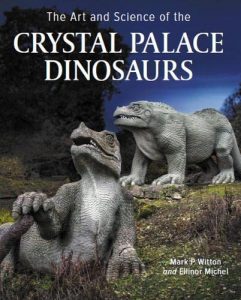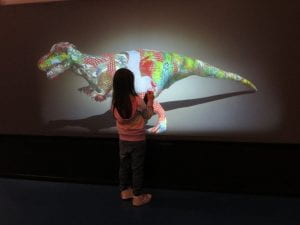By Mark P Witton and Ellinor Michel; published by The Crowood Press, 2022.
To anyone interested in palaeontology, the Crystal Palace Dinosaurs need no introduction. They were created in the Crystal Palace Park, in south London, as part of the development of the new park that housed the relocated Crystal Palace itself from its original site as the centrepiece of the Great Exhibition in Hyde Park in 1852. As the building itself was relocated, the surrounding parkland in Penge was developed, including ‘courts’ – themed areas showing different cultures in history – and one of these was the Geological Court, a display of British geology and palaeontology. This included life-size statues of prehistoric creatures, of which four are dinosaurs.
This book, published June 2022, is a comprehensive history and discussion of the models, the Geological Court and the background to the park. It is written by Mark Witton, palaeontologist, palaeoartist and author, and Ellinor Michel, evolutionary biologist, ecologist and taxonomist at the Natural History Museum, London*.
It is sumptuously illustrated, from photographs to maps to plans, in colour and with full annotation; it also includes Mark’s exquisite, contemporary new colour illustrations of the creatures as they are envisaged today.
The authors examine the science of the 19th century, the understanding of concepts such as Deep Time and explore the reasoning behind the planning and execution of such a grand project; throughout the book, detailed and thorough referencing support the discussion. This not a “dry” academic book, however, the writing is engaging and clear and the story is well structured and told. There is new material here, including a revision of the perceived wisdom around the influence and involvement of Richard Owen, and the contributions from Benjamin Waterhouse Hawkins and others working alongside him.
This is an important volume, not only for palaeontologists, but for historians and philosophers of science and art. The Victorian mindset, perceptions of new science concepts and consideration of public engagement of science form the backdrop to the discussion of the statues themselves. The Crystal Palace Dinosaurs are listed on Historic England’s National Heritage List for England as a Grade 1 site, and also on the Heritage At Risk Register. They remain a site of international importance.
*Ellinor is also co-founder and Chair of the Friends of the Crystal Palace Dinosaurs, https://cpdinosaurs.org/, a charity founded in 2013 to promote the long-term conservation of the statues and geological site and to engage the public with the history and science of the park. All proceeds of the book will go to supporting their aims.




















